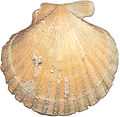Small pilgrim shell
| Small pilgrim shell | ||||||||||||
|---|---|---|---|---|---|---|---|---|---|---|---|---|

Small pilgrim mussel ( Aequipecten opercularis ) |
||||||||||||
| Systematics | ||||||||||||
|
||||||||||||
| Scientific name | ||||||||||||
| Aequipecten opercularis | ||||||||||||
| ( Linnaeus , 1758) |
The small pilgrim mussel ( Aequipecten opercularis ), also called the small scallop , is a type of mussel from the family of the scallops (Pectinidae).
features
The housings are only slightly unevenly hinged, the top left flap is usually slightly more arched than the lower right flap. The housing is roughly rounded to slightly ovoid in outline (slightly higher than wide) with a maximum diameter of five to nine centimeters. The vertebra is pointed and protrudes over the dorsal margin. Ears are formed in front of and behind the vertebra. The front ear is significantly larger than the back ear. The back ear is cut obliquely to the outside, the front edge of the front ear runs slightly obliquely inwards. The anterior ear of the lower right valve has a clear incision below for the byssus and bears four to five strong radial ribs. It therefore also has an approximately rectangular shape. The dorsal margins in front of and behind the vertebra are straight to slightly concave, the anterior dorsal margin is slightly shorter than the posterior dorsal margin. Apart from these small differences, the flaps are almost equilateral. The ligament lies inside under the vertebra in a triangular pit. The lock is toothless. In the adult stage, there is only a single large sphincter located in the rear part of the housing. The surface line is entire and the lock is toothless.
The surface has 18 to 22 rounded, wide ribs; the spaces between the ribs are about as wide as the ribs themselves. Ribs and spaces between the ribs show fine radial lines. The color varies from light yellow to dark brown, sometimes with reddish spots and rarely also white.
Geographical distribution and habitat
The distribution area of the species extends from northern Norway to the Mediterranean and the Canary Islands . In the North Sea they occur as far as Heligoland . However, they probably do not reproduce there; instead, the animals get there as larvae. They live from about four meters water depth to over 2,600 meters water depth on solid ground or soft sediment.
Way of life
The young animals are attached to a hard substrate with byssus, with the right flap facing down. They also have two sphincters and lock teeth. With age, the lock teeth recede and the anterior sphincter is reduced. Adult animals usually live freely on the sediment. In the event of danger, they can float up by quickly closing and opening the housing using the recoil principle and swimming a few meters further. The animals have a larger number of eyes on the edge of their coat, which react to movement and shading. She is quite agile and swims relatively often. It feeds on plankton.
Taxonomy
The species was first scientifically described by Carl von Linné in 1758 in the combination Ostrea opercularis . In the older literature, the taxon is also known as Chlamys opercularis or Pecten opercularis . According to the World Register of Marine Species , it is currently assigned to the genus Aequipecten P. Fischer, 1886. It is the type species of the genus Aequipecten P. Fischer, 1886 by monotype. The genus Aequipecten is placed in the subfamily Pedinae Bronn, 1862.
supporting documents
literature
- S. Peter Dance, Rudo von Cosel (arrangement of the German edition): The great book of sea shells. 304 p., Verlag Eugen Ulmer, Stuttgart, 1977 ISBN 3-8001-7000-0 (p. 233/4 as Chlamys opercularis )
- Fritz Nordsieck : The European sea shells (Bivalvia). From the Arctic Ocean to Cape Verde, the Mediterranean Sea and the Black Sea. 256 p., Gustav Fischer Verlag, Stuttgart 1969 (p. 49)
- Guido Poppe and Yoshihiro Goto: European Seashells Volume 2 (Scaphopoda, Bivalvia, Cephalopoda) . 221 p., Verlag Christa Hemmen, Wiesbaden 1993 (2000 unc. Reprint), ISBN 3925919104 (p. 63/4 as Chlamys opercularis )
- Rainer Willmann: Mussels and snails of the North and Baltic Seas. 310 p., Neumann-Neudamm, Melsungen 1989, ISBN 3-7888-0555-2 (p. 106)
Individual evidence
- ^ Carl von Linné: Systema naturae per regna tria naturae, secundum classes, ordines, genera, species, cum characteribus, differentiis, synonymis, locis. Tomus I. Editio decima, reformata. Pp. 1–824, Holmiae / Stockholm, Salvius, 1758. Online at Göttingen Digitization Center (p. 698 as Ostrea opercularis ).
- ↑ a b World Register of Marine Species: Aequipecten opercularis (Linnaeus, 1758)



